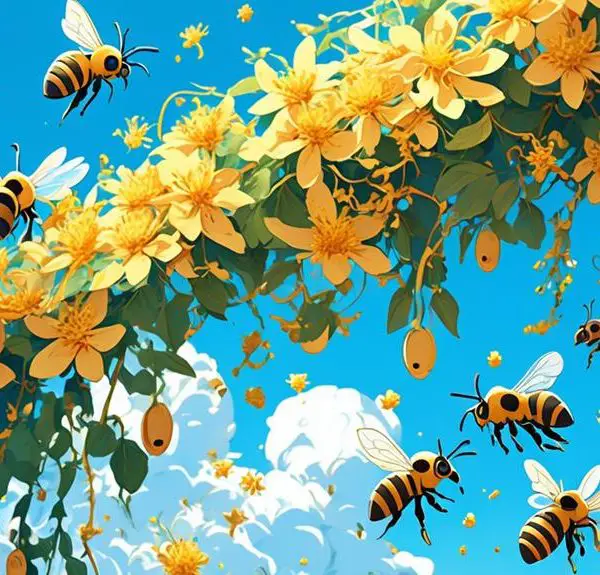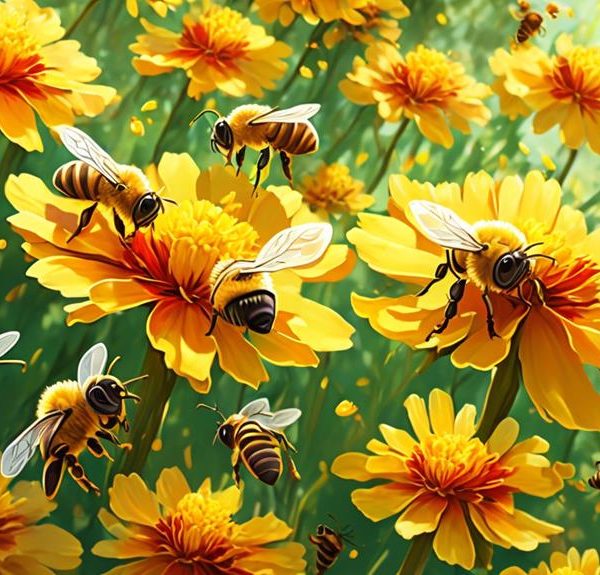Hang onto your curiosity as we explore if the vibrant clematis is a preferred choice for bees, our diligent pollinators.
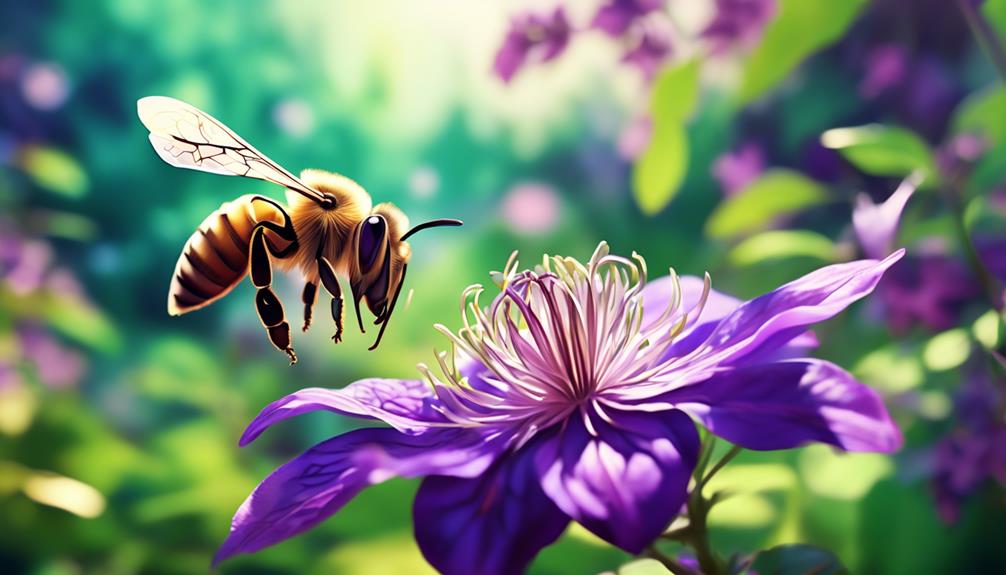
Do Bees Like Clematis?
You might have noticed the buzzing of bees around your garden. You might have seen them darting from flower to flower. And you might have wondered if they have a preference.
One such curiosity that might have crossed your mind is whether bees are attracted to the vibrant, sprawling clematis. Clematis, with its myriad of colors and shapes, adorn many gardens. But does it allure bees?
Let's hang on that thought for a moment and explore the fascinating world of these diligent pollinators, their preferences, and their relationship with the delightful clematis.
Key Takeaways
- Bees are attracted to flowers rich in nectar and pollen, and clematis flowers serve as a rich source of both.
- Clematis flowers have vibrant colors, especially blue and violet, which are preferred by bees.
- Bees are drawn to the ultraviolet patterns on clematis petals that guide them to the nectar-rich center.
- The shape and structure of clematis flowers make it easy for bees to access the nectar and pollen, promoting the pollination process.
Understanding Bee Attraction Factors
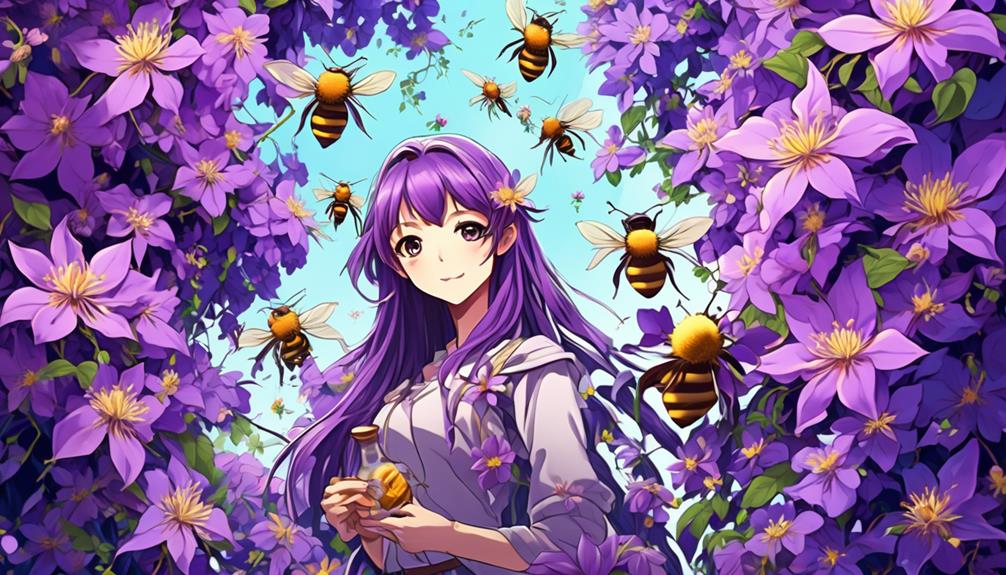
To fully grasp why bees might be attracted to clematis, it's crucial to understand the key factors that generally lure these pollinators. Bees use their keen sense of smell to locate flowers rich in nectar and pollen. These food sources provide the necessary nutrients for their survival and hive sustenance. The scent in clematis, like many other flowering plants, can be an irresistible magnet to bees.
Color is another significant factor. Bees aren't colorblind as you might think. They see the world in a spectrum different from ours, with an enhanced perception of blue and ultraviolet light. The vibrant hues of clematis make it a visible beacon for bees, signaling a potential feast.
Shape and structure play a role too. Bees prefer flowers with landing platforms or tubular structures that offer easy access to nectar. Clematis, with its radial symmetry and accessible center, fits this profile perfectly.
The Colorful World of Clematis
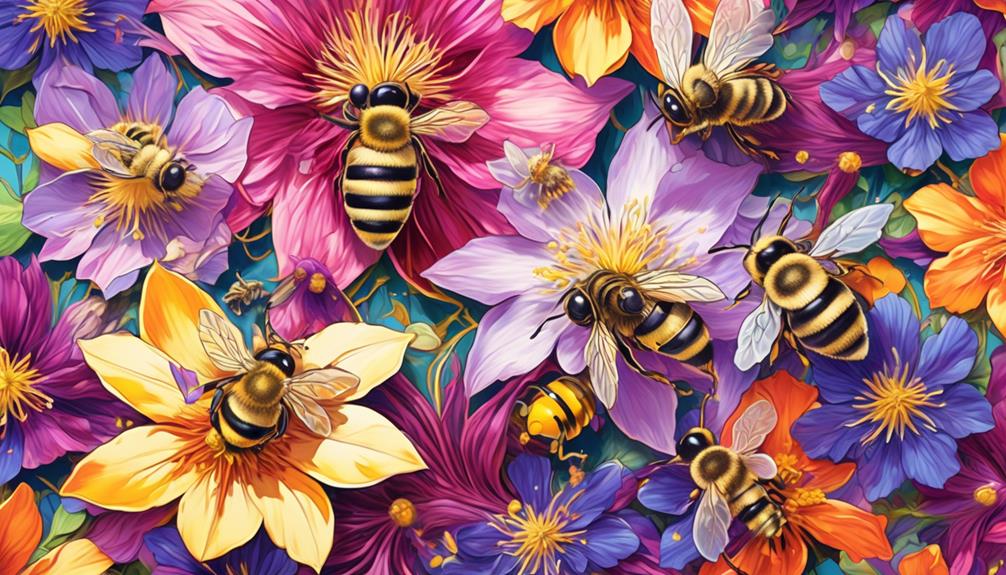
Often, you'll find clematis blooming in a dazzling array of colors, presenting a vibrant spectrum that not only appeals to our human aesthetic but also proves highly attractive to bees. This broad color palette, ranging from deep blues to vibrant reds and subtle whites, plays a vital role in attracting bees to these flowers.
Scientific studies suggest bees have an innate preference for blue and violet hues, colors which are abundantly represented in many clematis species. They're also drawn to the ultraviolet patterns on the petals that guide them to the flower's nectar-rich center. These patterns, invisible to the human eye, serve as landing guides for bees, leading them directly to the nectar.
Clematis flowers also appeal to bees due to their shape and structure. Many clematis varieties have a flat, open shape, making it easy for bees to access the nectar and pollen. The large size and prolific blooming nature of clematis make them a prominent feature in the garden, helping to draw in bees from a distance.
In essence, the colorful world of clematis is a veritable bee magnet, where color, form, and function synchronously blend to attract these essential pollinators.
Bees' Interaction With Clematis
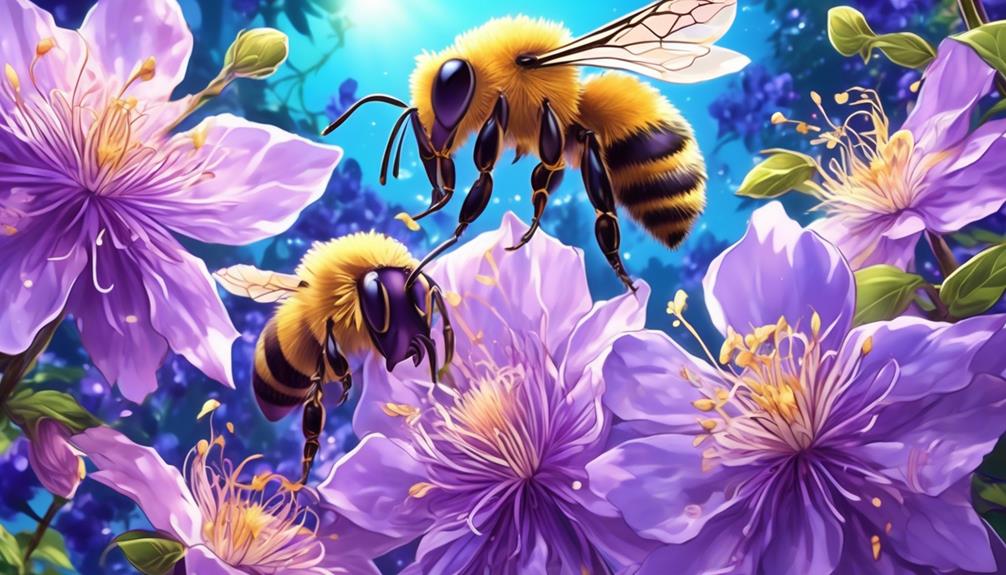
As a bee approaches a clematis flower, it's immediately drawn to the vivid coloring and ultraviolet patterns, initiating a complex interaction that's crucial for both the insect and the plant. The bee, in its quest for nectar, unknowingly collects pollen on its body. This pollen transfer, or pollination, is a vital part of the flower's reproductive process.
But how exactly does this interaction occur? You might be surprised to know it's not as simple as it seems. The clematis flower has evolved a specialized structure called a nectary at the base of its sepals. When a bee lands on a clematis flower, it's lured towards this nectary by the flower's UV light patterns, which are invisible to the human eye but highly attractive to bees.
The bee pushes past the stamens to reach the nectar, getting dusted with pollen in the process. When the bee moves on to the next flower, some of the pollen rubs off on the flower's stigma, completing the process of pollination.
This symbiotic relationship between bees and clematis isn't only fascinating but also necessary for the survival of both species.
The Role of Clematis in Pollination
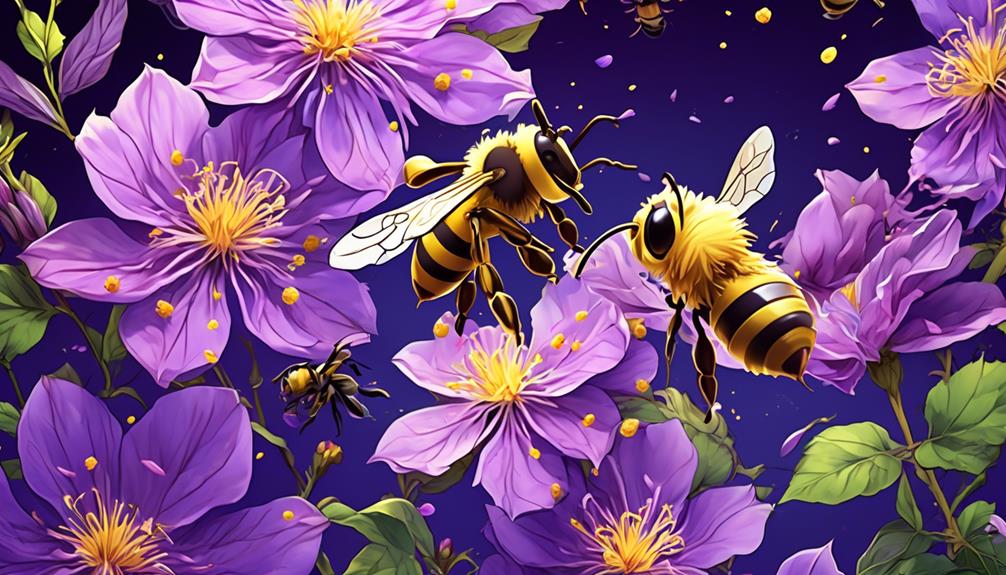
In the grand scheme of pollination, clematis flowers play a crucial role, serving as a rich source of nectar and pollen for bees. You'll find that bees, in their quest for food, visit these flowers, inadvertently picking up pollen that's then transferred to the next flower they visit. This cross-pollination ensures genetic diversity, essential for the survival and robustness of plant species.
It's worth noting that not all clematis types are equal when it comes to bee attraction. Different species have different levels of nectar and pollen, making some more attractive to bees than others. To illustrate, let's refer to the table below:
Clematis Type | Nectar Level | Pollen Level |
|---|---|---|
C. montana | High | Medium |
C. 'Nelly Moser' | Medium | High |
C. 'Jackmanii' | Low | Medium |
C. armandii | Medium | Low |
C. 'Duchess of Edinburgh' | High | High |
Studying this table, you can see how different clematis varieties influence bee attraction and, consequently, their role in pollination. By understanding such relationships, you're better equipped to contribute to pollinator-friendly gardening and biodiversity conservation.
Other Flowers Bees Love
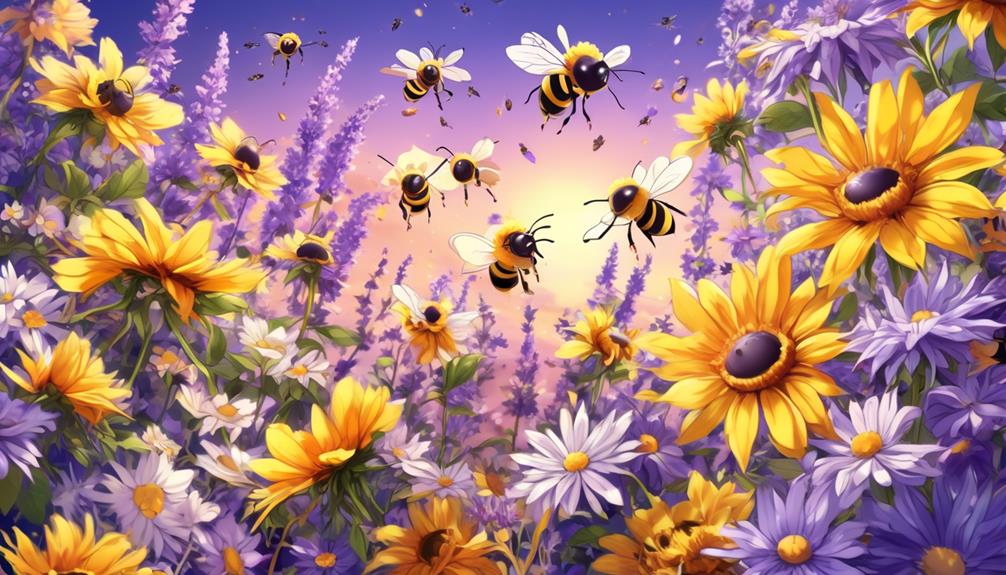
While clematis varieties certainly attract bees, they're not the only flowers these industrious pollinators favor. You'll find that bees have a particular affinity for flowers that are rich in nectar and pollen, their primary food sources. Sunflowers, lavender, and marigolds are among their favorites. The bright, large sunflower heads offer a wide landing pad and abundant food. Lavender, with its fragrant purple spikes, provides nectar throughout the summer. Marigolds, too, are a hit with bees, their intense orange color signaling a rich nectar source.
Bees also value the daisy family, especially Echinacea and Aster varieties. Echinacea, or cone flowers, are particularly loved for their high nectar content and their large, flat petals which provide an easy landing spot. Asters, on the other hand, bloom late, providing sustenance when other sources are scarce.
But let's not forget herbs. Thyme, chives, and borage are all high on bees' preference list. These herbs offer plentiful nectar and have the added benefit of blooming for a long duration.
As a gardener, you can use this information to create a bee-friendly environment, contributing to the survival and health of these vital pollinators.
Enhancing Your Garden for Bees
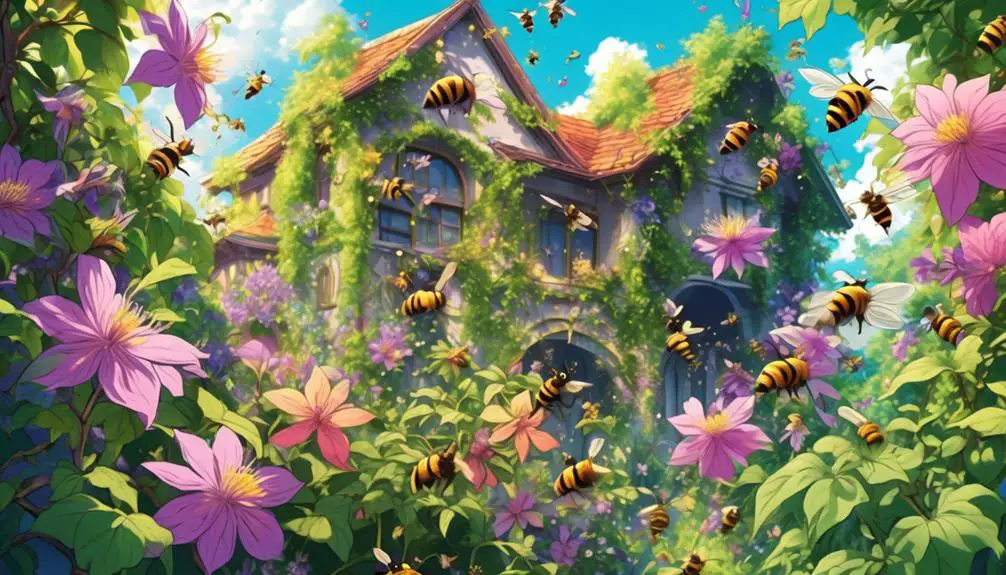
To make your garden more appealing to bees, you'll need to consider a few key factors including flower diversity, water availability, and the presence of native plants.
Flower diversity is crucial; aim for a range of different flowers that bloom at varying times throughout the year. This ensures that bees have a continuous source of nectar and pollen. You'll want to include both single and double flowering plants as bees are attracted to both.
Water availability is another crucial factor. Bees need water for their survival and reproduction. You can provide this by having a birdbath or a small pond in your garden. If that's not feasible, even a simple dish with water can suffice.
Incorporating native plants into your garden is also important. Bees have evolved with these plants and are therefore more likely to be attracted to them. They also require less maintenance and are more resistant to pests and diseases.
Lastly, avoid using pesticides as they can harm bees. Instead, opt for organic gardening methods.
Frequently Asked Questions
What Types of Bees Are Most Likely to Be Attracted to Clematis?"
You're most likely to see honey bees and bumblebees buzzing around your clematis. These types of bees are attracted to the colorful, large flowers of the clematis. They're drawn to the abundance of nectar and pollen these plants offer.
That's not to say other bees won't visit, but honey bees and bumblebees are the most common. Planting clematis is a great way to support these essential pollinators.
Can the Smell of Clematis Harm Bees in Any Way?"
No, the scent of clematis doesn't harm bees. In fact, bees are often enticed by this fragrance, leading them to the plant's pollen and nectar.
It's important to remember that bees have a vital role in pollination and strong, pleasant floral scents play a big part in this.
What Time of Year Do Bees Interact Most With Clematis?"
You're likely to see bees interacting with clematis most often in the spring and early summer. This is when clematis is in its blooming period and offers the most nectar. Bees are attracted to the scent and color of the flowers. They'll buzz around, pollinating as they go, contributing to the plant's reproductive process.
It's a mutualistic relationship – the bees get food, and the clematis gets pollinated.
How Can Clematis Affect the Honey Produced by Bees?"
When bees feast on clematis nectar, it influences the taste, color, and texture of their honey. You'll notice a distinct flavor profile that's unique to clematis, slightly more floral and fragrant. The honey's color might also be subtly different, perhaps a tad darker.
It's a fascinating process, how the type of nectar bees collect can impact the characteristics of the honey they produce. So, yes, clematis does indeed affect the honey produced by bees.
Is It Possible for Clematis to Attract Too Many Bees, to the Point of It Becoming a Problem?"
You're asking if clematis can attract an overabundance of bees, potentially causing issues. Well, it's possible. Clematis, like other flowering plants, can become a major draw for bees. However, it's rare for this to become problematic.
Bees are generally non-aggressive and beneficial for the environment. If you're concerned about a high number of bees, you might want to consider diversifying your garden with plants that attract a variety of pollinators.
Conclusion
In conclusion, bees are indeed drawn to Clematis, thanks to its vibrant colors and nectar-rich blossoms.
This vine's role in pollination is paramount, aiding in the ecosystem's balance.
By adding Clematis and other bee-favored flowers to your garden, you're not only enhancing its beauty, but also contributing positively to bee populations.
So, let's embrace our buzzy friends, and cultivate a garden that keeps these vital pollinators buzzing happily and healthily.

